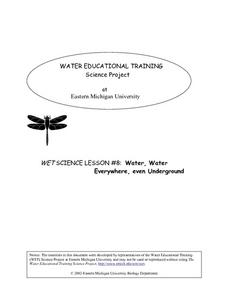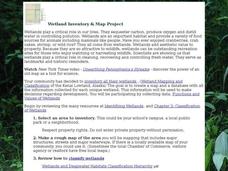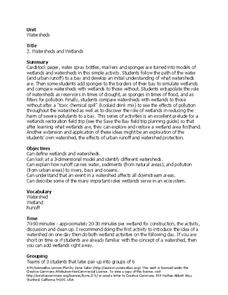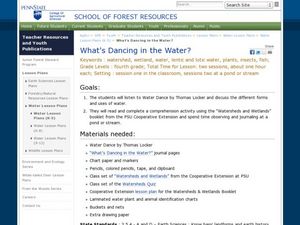Michigan Sea Grant
Environmental Decision Making
Pupils participate in a board game activity in which landing on a space called "Decision Card" presents them with a land-use situation to consider and decide how to act. In order to advance in Hydropoly, players must think critically and...
Curated OER
Wetlands/Migration
Students use a hopscotch course to simulate the problems birds incur as they are migrating due to loss of wetlands.
Curated OER
Water Plants
Young scholars examine the plants and animals that make their home in wetlands. While observing, they make sketches of the ones they see with a pencil. To end the lesson, they use watercolors to paint their flowers and animals at the...
Curated OER
Water, Water Everywhere, Even Underground
The "Engage" section of a wetlands lesson plan asks young ecologists to examine a wetlands poster. You can easily find one online and display it using a projector. Pupils immerse a piece of sandstone and a piece of granite in water to...
Curated OER
Sounds of the Wetlands
Learners identify the sounds of different bird calls. In this biology lesson, students create a sound map. They explain how this method is important in tracking wildlife.
Curated OER
Dawdle Duckling
Students read the book Dawdle Duckling and complete different activities about the book. Students research the wetlands, research ducks, complete an oil and water experiment, map a cove, and more.
Curated OER
Exploring Our Watershed System
Students study watersheds and examine how they are composed. In this watershed system lesson students explain how water enters a watershed and the concept of stream order.
Curated OER
Wetland in a Pan
Middle schoolers examine wetlands and what the effects of destroying them will do. In this wetland lesson students relate the importance of wetland functions to their own needs.
Curated OER
Wetland Habitats
Eighth graders explore the program Alice and the Internet to research wetland habitats. In this habitat instructional activity students build their own Alice world that includes wetland habitats, food sources and ways to...
Curated OER
Wetlands - Food Web Relationships
In this food web relationships worksheet, students click on the links to learn about the food web relationships in the wetlands and answer short answer questions about it. Students complete 8 questions total.
Curated OER
Face Facts: Wetlands trees and plants quiz
In this Wetlands instructional activity, students take a multiple choice quiz about the trees and plants of the Wetlands. Students complete 15 multiple choice questions online.
Curated OER
Wetlands Mammals Facts Table
In this mammals worksheet, students complete this graphic organizer about different mammals in the Wetlands. Students complete 40 boxes in the graphic organizer.
Curated OER
Wetlands Issues
In this wetlands learning exercise, students write questions for topics in a game about the wetlands. Students write 5 questions for each topic.
Curated OER
Wetland Inventory and Map Project
In this wetlands inventory and map project worksheet, learners do research on the wetlands and complete a map project about it. Students follow 6 sets of directions with Internet links.
Curated OER
Trees and Plants of the Wetlands
In this trees and plants of the wetlands worksheet, students click on the links in the questions about trees and plants to find the answers to the questions and then come back and answer the questions. Students answer 27 questions total.
Curated OER
How do rice farmers make good use of the land they use for planting rice?
Second graders discuss how farmers grow rice. In this rice growing instructional activity, 2nd graders see the optimal condition for land in order to grow rice. They experiment with clay and garden soil to see which holds water...
Curated OER
Watersheds and Wetlands
Students simulate a chemical spill. In this watersheds and wetlands lesson, students build a watershed and observe what happens when it rains. Students add wetlands to their watershed models and examine the effects of water pollution.
Curated OER
Temperate Forests vs. Wetlands
Students compare and contrast the temperate forest and wetlands by researching them in groups. In this forest lesson plan, students identify the economic, ecological, and social benefits of each.
Curated OER
What's a Swamp Good For?
Young scholars identify the function and value of wetlands. In this lesson on appreciating wetlands, students explain how different household items can represent different aspects of the wetlands.
Curated OER
All Hands on Deck: A Harbor Education Program
Students build a model of an estuary. In this wetland lesson, students build a model estuary with a paint tray and modeling clay. They use the model to illustrate the impact of non-point pollution on the watershed.
Curated OER
What's Dancing in the Water?
Students learn about watershed, as well as the different forms and uses of water. In this water forms lesson, students brainstorm water sources and uses. Students read the book Water Dance and discuss water examples. Students complete a...
Curated OER
Watersheds and Wetlands
Students investigate watersheds and wetlands. In this watersheds and wetlands instructional activity, students complete a 17 step lesson plan to build a watershed. Students then complete another 9 step instructional activity to build a...
Curated OER
Stream
Students examine stream waters. In this scientific inquiry lesson, students "explore" wetlands as they participate in a demonstration that reveals information about steam waters and insects.
Curated OER
Lake Log: Diary of the Basin
Students log news articles about the changes in the Lake Pontchartrain Basin. In this wetlands and news instructional activity, students track articles about the wetlands area around Lake Pontchartrain, write brief summaries, include...

























